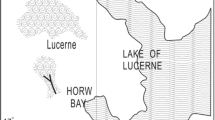Abstract
The isotopic ratios of sulfur and carbon in the tissues of infanal organisms collected from a natural petroleum seep in the Santa Barbara Channel, California, USA were examined to see if petroleum is utilized by the benthic community. Sulfur isotope data were consistent with a pathway of petroleum energy from sulfate reducers → H2S → Beggiatoa sp. → nematodes and other infauna. The carbon of infaunal organisms was isotopically lighter at the seep than at a comparison station; the mean δ13C for 12 species was-1.32‰ towards the petroleum δ13C value. The shifts were largest in two species of deep-feeding maldanid polychaetes. The tissues of one of the species, Praxillella affinis pacifica, were also analyzed for 14C content and δ34S, and the biomass produced by the populations over 26 mo was estimated. The results of these analyses allowed us to estimate that for the seep population: (1) there was 15.6% more fossil carbon, (2) chemoautotrophic bacteria contributed 13.6% more carbon, and (3) 19% more carbon was produced by the population over 26 mo. In spite of the possible sources of error, these values are in reasonable agreement. In general, these data infer that, although petroleum utilization by the benthic food web proceeds both directly through heterotrophs and indirectly through chemoautotrophs, the two pathways are tightly coupled. A carbon budget for P. affinis pacifica was constructed with three assumed sources: chemoautotrophic biomass, petroleum carbon utilized heterotrophically, and nonexotic carbon utilized heterotrophically. Calculations based on this budget indicate that the food web is fueled to a greater extent by the isotopically lighter gases than by the liquid oil.
Similar content being viewed by others
Literature Cited
Barker, J. F. and P. Fritz: Carbon isotope fractionation during microbial methane oxidation. Nature, Lond. 293, 289–291 (1981)
Davis, P. H. and R. B. Spies: Infaunal benthos of a natural petroleum seep: study of communicy structure. Mar. Biol. 59, 31–41 (1980)
DeNiro, M. J. and S. Epstein: Influence of diet on the distribution of carbon isotopes in animals. Geochim. cosmochim. Acta 42, 495–506 (1978)
DeNiro, M. J. and S. Epstein: Influence of diet on the distribution of nitrogen isotopes in animals. Geochim. cosmochim. Acta 45, 341–353 (1981)
DesMarais, D.: A variable temperature cryogenic trap for the separation of gas mixtures. J. analyt. Chem., Wash. 50, p. 1405 (1978)
Fehlbeck, H., J. J. Childress and G. N. Somero: Calvin-Benson cycle and sulfide oxidation enzymes in animals from sulfiderich habitats. Nature, Lond. 293, 291–293 (1981)
Haines, G. B.: Relation between stable carbon isotope composition of fiddler crabs, plants and soils in a salt marsh. Limnol. Oceanogr. 21, 880–882 (1976)
Howarth, R. W. and J. M. Teal: Energy flow in a salt marsh ecosystem: the role of reduced inorganic sulfur components. Am. Nat. 116, 862–872 (1980)
Jaanasch, H. W. and C. O. Wirsen: Chemosynthetic primary production at East Pacific sea floor spreading centers. BioSci. 29, 592–598 (1979)
Jørgensen, B. B.: Distribution of colorless sulfur bacteria (Beggiatoa spp.) in a coastal marine sediment. Mar. Biol. 41, 19–28 (1977)
Jørgensen, B. B.: Mineralization and the bacterial cycling of carbon, nitrogen and sulfur in marine sediments. In: Contemporary microbial ecology, pp 239–251. Ed. by D. C. Ellwood, J. N. Hedger, M. J. Latham, J. M. Lynch and J. H. Slater. London: Academic Press 1980
Kaplan, I. R., K. O. Emery and S. C. Rittenberg: The distribution and isotopic composition of sulfur in recent sediments off southern California. Geochim. cosmochim. Acta 27, 297–333 (1963)
Kaplan, I. R., T. A. Rafter and J. R. Hulston: Sulfur isotopic variations in nature. Part 8. Application to some biogeochemical problems. N.Z. Jl Sci. 3, 338–361 (1960)
Karl, D. M., C. O. Wirsen and H. W. Jaansch: Deep-sea primary production at the Galapagos hydrothermal vents. Science, N.Y. 207, 1345–1347 (1980)
Kepkay, P. E., R. C. Cooke and J. A. Novitsky: Microbial autotrophy: a primary source of organic matter in marine sediments. Science, N.Y. 204, 68–69 (1979)
Kepkay, P. E. and J. A. Novitsky: Microbial control of organic carbon in marine sediments: coupled chemoautotrophy and heterotrophy. Mar. Biol. 55, 261–266 (1980)
Knap, A. H., P. J. Williams and I. Taylor: Contribution of volatile petroleum hydrocarbons to the organic carbon budget of an estuary. Nature, Lond. 279, 517–519 (1979)
Myers, E. P.: The concentration and isotopic composition of carbon in marine sediments affected by sewage discharge, 179 pp. Ph.D. dissertation, Pasadena, California: California Institute of Technology 1974
Postgate, J. R.: The sulfate-reducing bacteria, 151 pp. Cambridge: Cambridge University Press 1979
Rau, G. H. and J. J. Hedges: Carbon-13 depletion in a hydrothermal vent mussel: suggestion of a chemosynthetic food source. Science, N.Y. 203, 648–649 (1979)
Reed, W. E. and I. R. Kaplan: The chemistry of marine petroleum seeps. J. geochem. Explor. 7, 255–293 (1977)
Spies, R. B. and P. H. Davis: The infaunal benthos of a natural oil seep in the Santa Barbara Channel. Mar. Biol. 50, 227–237 (1979)
Spies, R. B., P. H. Davis and D. H. Stuermer: Ecology of a submarine petroleum seep off the California coast. In: Marine environmental pollution. Vol. 1. Hydrocarbons pp 224–263. Ed. by R. A. Geyer. Amsterdam: Elsevier 1980
Thode, H. G., H. Kleerekoper and D. McElcheran. Isotope fractionation in the bacterial reduction of sulfate. Research, Lond. 4, 581–582 (1951)
Williams, P. M., K. L. Smith, E. M. Druffel and T. W. Linick: Dietary carbon sources of mussels and tubeworms from Galapagos hydrothermal vents determined from tissue 14C activity. Nature, Lond. 292, 448–452 (1981)
Zajic J. E. Microbial biogeochemistry, 345 pp. New York: Academic Press 1969
Author information
Authors and Affiliations
Additional information
Communicated by N. D. Holland, La Jolla
Rights and permissions
About this article
Cite this article
Spies, R.B., DesMarais, D.J. Natural isotope study of trophic enrichment of marine benthic communities by petroleum seepage. Mar. Biol. 73, 67–71 (1983). https://doi.org/10.1007/BF00396286
Accepted:
Issue Date:
DOI: https://doi.org/10.1007/BF00396286




